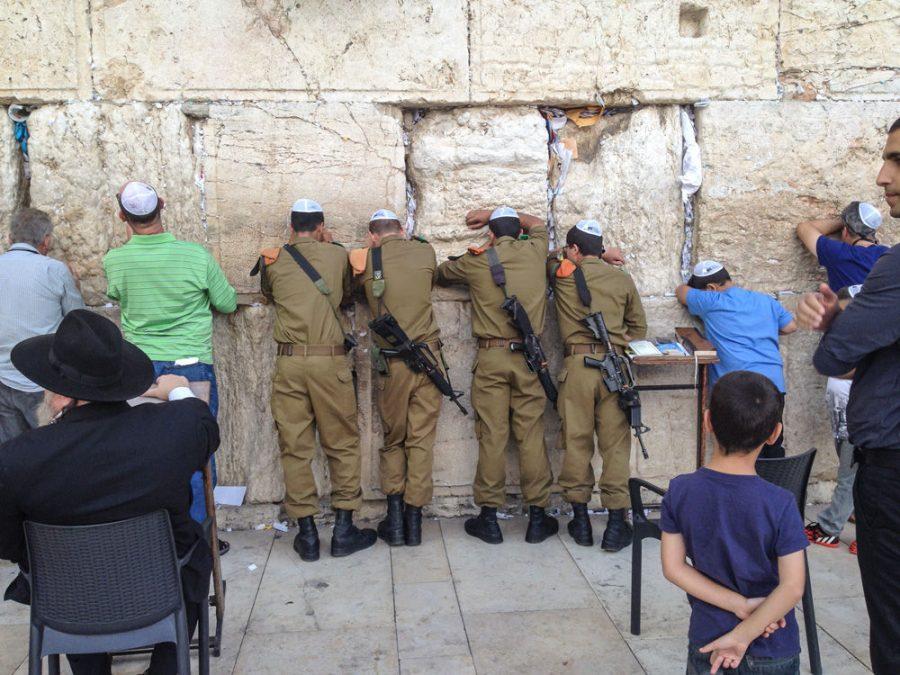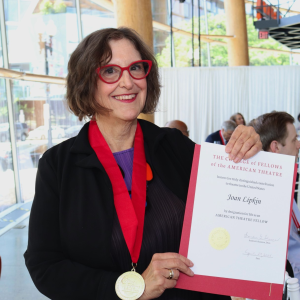Israel tour reveals unexpected riches
Published January 14, 2015
Rabbi James Bennett of Shaare Emeth told us that the October trip to Israel he was planning would be one that “most people never experience.” Still, I did not anticipate much more than visiting the traditional sites on what would be my first visit. But nothing could have prepared me for the Jewish State I experienced.
I never expected to be escorted into a network tunnels under the Wailing Wall, the wall believed to be the Western Wall of the platform built to support the Second Temple. As we descended, we passed archeological ruins that had begun to be excavated in 1864 and are still being uncovered. Standing underground on bedrock, an engineer explained how the massive building blocks were cut and placed on top of each other.
Certainly, I did not anticipate finding an ancient synagogue on top of Masada, the Judeanfortress high on an isolated plateau where more than 900 Jews committed suicide rather than surrendering to invading Romans in 73 C.E Nor did I expect to find a Jewish scribe in the tiny building penning a Torah scroll in Hebrew calligraphy. It seemed fitting testimony that we still exist despite the deadly mountaintop siege.
I was somewhat prepared to relive the horrific history of the Holocaust presented at Yad Vashem, the museum that chronicles the Holocaust. But I did not anticipate the dramatic symbolism Jewish architect Moshe Safdie incorporated into the building’s architecture.
The route through the museum crisscrosses a central atrium as it winds its way past galleries presenting a chronological history of the Holocaust that is emotionally difficult to watch. At first, the atrium walls tower overhead and slant inward. The sensation is that escape would be impossible, not just for European Jews during World War II, but even from the museum.
As a tour continues in and out through the atrium, the height of the walls progressively lowers. Exiting the last gallery, the walls make a graceful bend outward exposing an open-air balcony and a dramatic view of sunlit, modern Jerusalem.
Similar to the scribe on Masada, the message of the architecture is that once again, we survived and are prospering in our own land.
I never expected to see a mezuzah on every passageway in the airport, or every hotel guest room door. Or a store selling only yarmulkes that covered every wall, window and door. Or a huge revolver strapped to the waist of a young blond woman greeting guests at the Inbal Hotel in Jerusalem.
In southern Israel, on what was a 5,000-year-old Bronze Age agricultural site, a dirt road led to the top of a hill and the Kornmehl Goat Farm. Who could have imagined I would be eating a delicious lunch in wooden train cars repurposed into a tiny open-air restaurant facing a pen of goats? The menu described the extraordinary care the goats receive and how the cheese-based fare is a “personal interpretation of famous French varieties of cheese” that owner Dan Kornmehl studied in France.
A farmer in the Negev told me that Arabian leopards roam the barren Israeli desert hills. Huge yellow signs in the Negev advise motorists to “beware of camels near the road.”
Not far from Tel Aviv, in the laundry building of a 1940s-era kibbutz that has been turned into a museum, a docent revealed – much to our surprise – that we were sitting on top of a secret ammunition plant. In the mid-1940s, it made bullets for the anticipated war that broke out when Israel was declared a nation May 14, 1948. She pushed aside an industrial-size washing machine and we ventured down steep steps into the underground plant.
Beyond the unexpected sights, I suspect that years from now, the stories and attitude of the Israeli citizens I met that will remain the most vivid memories.
The retired army colonel
Miri Eisin was 11 when she arrived in Israel with her family form California. Now 52, she spoke about the nation’s security challenges, and she knew the topic well. She had served in the Israeli military for 22 years and two wars, mostly in the military intelligence corps. In her last position, she was deputy head of the combat intelligence corps.
Eisin had made herself familiar with Missouri to better impress us with the size, and thus the vulnerability, of Israel to aggression.
“Driving Israel west to east takes less time than driving from St. Louis to Columbia,” she said. “Israel is 1/12th the size of Missouri. Imagine if America was that size and was surrounded by hostile neighbors. The security consequences are enormous. This is the neighborhood we live in.”
The old soldier
Perched on a rounded mountaintop in far northern Israel with a panoramic view of Lebanon on three sides, muffled explosions could be heard echoing across the valley from Syria, where a civil war is being fought. It is where Kibbutz Misgav Am shares the land with a small Israeli army base, and it has been home to Cleveland born Aryeh Ben-Yaakov for 54 years.
“I witnessed a lot of anti-Semitism when I was in America” he told us. “I decided Israel was my real home.”
Ben-Yaakov was 21 when he arrived and started farming cotton on the kibbutz he still calls home. His devotion to his new nation was tested four times. He fought in the1967 Six Day War, the 1967-70 War of Attrition, the 1973 Yom Kippur War and the 1982 Lebanon War.
Today, at age 74, he is still ready to defend Israel. Motioning past a fence only 20 feet away that defines the border with Lebanon, he raises his voice and says: “If they come over here looking for trouble, I’ll be waiting. This is my mountain and my home.”
The peace activist
Only an hour drive away we met Lydia Aisenberg who had a different attitude. She gave us a tour of the picturesque campus of Giv’at Haviva Institute, an organization where she has worked for over two decades helping to develop a better understanding between Israel’s Arab and Jewish populations.
Born in 1946, in South Wales, Britain, she retains a Welsh inflection still detectable in her English and Hebrew. When the Six Day War broke out in 1967 she was one of 5,000 volunteers that poured into Israel.
In 1969 she made aliyah to Mishmar Ha’emek kibbutz where she still lives. She married and is the mother of five boys who have all served in the Israeli army. “They will not wear the T-shirt I have on,” she says pointing to wording in Arabic and Hebrew promoting better understanding.
As she spoke of her friendships with Palestinians in nearby villages, she also talked of the fear and anger she felt when buses were blown up close to her home.
Still, Aisnberg affirmed her lifelong commitment to the process of dialogue and reconciliation. “During the recent conflict along the Gaza Strip, we had Arab and Jews lining the street in front of our institute holding signs reading ‘We deserve to live in peace,’” she said proudly.
The vineyard owner
Under a square of canvas tied to four posts in the Negev we sampled wine at a 10-acre winery with owner Eran Raz. His great-grandparents moved to Israel in the 1880s.
When Raz was 21 and training to become a team commander in a special-forces unit of the Israel Defense Forces, he asked his grandmother what she expected of him. “She told me we should continue to build this country,” he said. “I feel bringing the desert to life is accomplishing her vision and helping make Israel better, and that makes me very happy. I named this the Nana Winery in her honor.”
“Until I planted my first crop 14 years ago I had no idea the vineyard would be in the middle of a Bedouin drug smuggling route from Egypt into Israel,” he said. “The first year they would let their camels loose to graze and destroy my newly planted vineyard. I started camping there and they realized I was not leaving, or intent on causing them any trouble.”
The Bedouin
Inside one of the open-sided tents that made up one of thousands of shanties in numerous Bedouin communities throughout the Negev, we talked to Salem Sedes, a member of the Janabib tribe. He explained in Hebrew how his family has roamed the desert for hundreds of years, and that he believes it is the right of Bedouins to live anywhere they wish throughout the Middle East.
His positon is not shared by the Israeli government, which has pressured the Bedouins to move into more permanent housing. Most have refused.
He told us his village keeps camels mainly for milk, but sometimes for transportation. He said many Bedouins have college degrees and work in “normal” city jobs. Yet most return to the Bedouin’s simple way of life in what in America would be considered abject poverty. “We do not need much to be happy,” he said smiling.
“I would like you to tell me why someone else should tell us how and where to live,” he said. Then after a pause, he said he did not expect an answer. “I just want you to think about it. The world would be a better place if there were no borders.”
The young soldier
The lanky black Israeli-Ethiopian soldier with a yarmulke perched on top his shaved head and a menacing Israeli-made Tavor assault rifle slung across the front of his body was standing close by. He was one of a countless number of 18 to 20-year old men and women in the Israeli Defense Forces we encountered daily throughout Israel. As part of their armed forces training they tour sights important to Israel’s heritage.
We were at the entrance to Mount Herzl, the Israeli national cemetery where Theodor Herzl, the founder of modern political Zionism is buried along with other Israeli leaders.
“How does that stay on your head,” I asked pointing to his yarmulke while using the question as an excuse to talk. “I don’t know,” he said smiling and lifting it off his head to look at it himself. “But it stays on even when I run.” Then he was gone to tour the cemetery which also includes the final resting place for thousands of soldiers just like him, but who perished defending Israel.
The tour guide
Yael Friedman Vatury of the SY Travel Israel travel agency was our 36-year-old guide throughout the trip. Her grandparents moved to Israel in the early 1930s from Czechoslovakia and Hungary.
Vatury’s joy sharing anything we wanted to know about her country could not be contained. She was so enthusiastic she rose onto her tiptoes to make a point. Her knowledge was as complete as a Google search engine. Wherever we visited, her contributions made the experience more meaningful.
Vatury served in the Israeli army for five years, followed by eight years in a paratrooper reserve unit serving as head of weapons training. “I felt I was doing something meaningful for my country,” she said. “It was a real privilege to serve and not take living in an independent Jewish state for granted.”
She also shared her experience living in the French Hill section of Jerusalem. Out her window across a small valley was Issawiya, an Arab neighborhood and the center of unrest when we were there. She told us her car had recently been pelted with rocks while she and her mother, husband and children had been inside.
“The tension is building,” she said as we drove by her home where a group of heavily armed soldiers stood on a hill nearby. “It is more intense that it has been in a long time.”
Then, without realizing it, she repeated the same sentence spoken by Mimi Eisin who had briefed us about the security challenges facing Israel on the first day of our tour. “This is the neighborhood we live in,” Vatury said.















